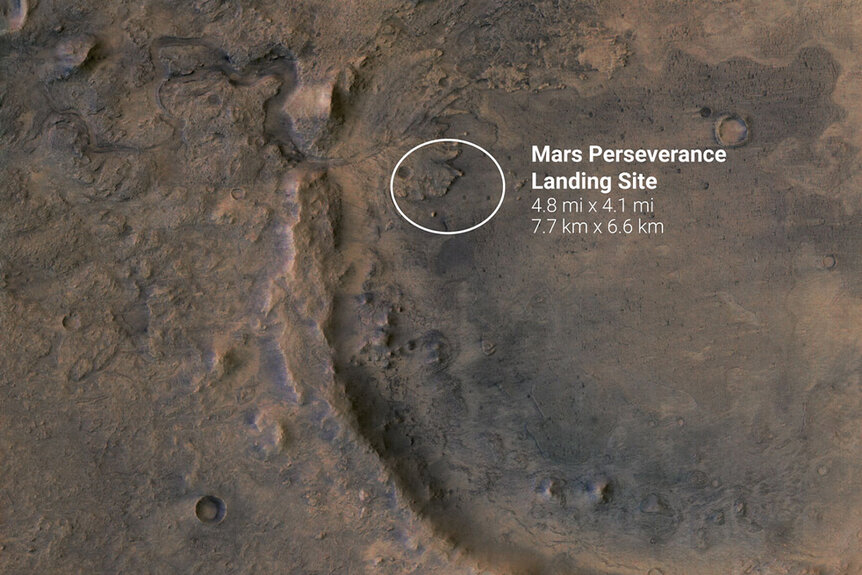Create a free profile to get unlimited access to exclusive videos, sweepstakes, and more!
See Mars’ Jezero Crater for yourself in this stunning video tour
To your left, you'll see a crater lake, and maybe even some aliens if you look closely.

Why would a person willingly strap themselves to a rocket and fly into the unknown? For the crew of The Ark (airing every Wednesday at 10 p.m. ET. on SYFY, streaming the next day on Peacock), the motivation is the imminent demise of the entire human species and the immediate necessity to find and build a new home for ourselves. That’s a pretty good motivator, but it isn’t the only one. Astronauts, cosmonauts, taikonauts, basically every kind of naut you can think of, have been knowingly blasting themselves into orbit for the better part of a century, knowing full well it was likely the most dangerous thing they would ever do.
In fact, space agencies around the world are constantly turning people away. They don’t have enough seats to accommodate everyone who wants to go. So, what gives? There’s nothing out there in space, in the way of things to do. There are no malls, no movie theaters, no ancient ruins, killer nightlife, and no air. That’s sort of a problem. By nearly every measure, space is an awful place to be. Earth is our one sanctuary in a universe which would happily rob us of life without a single care. And yet, we don’t even question why people do it. We (humanity) do it because we feel compelled to know what exists beyond the next horizon.
RELATED: Dean Devlin & Jonathan Glassner on what separates SYFY's ‘The Ark’ from other sci-fi shows
Following the success of NASA’s Curiosity rover, the agency got to work designing their next Martian exploratory rover, with the aim of gathering Martian rock samples for later return to Earth. The project was ambitious, and NASA wanted their Perseverance rover, nicknamed “Percy,” to have the highest probability of success. They made a car-sized machine, custom built for a specific purpose, to seek out signs of ancient life on a remote desert planet.
Success would mean having the right equipment and more than a little bit of luck, but it also meant choosing the right location for Percy’s search. Scientists settled on Jezero crater, a depression roughly 28 miles (45 kilometers) across, located in the Syrtis Major quadrangle. It is what remains of an ancient crater lake, with inflows and outflows. If life exists on Mars, or if it ever existed, this is the sort of place you might expect to find it.
Over the course of more than 700 sols (Martian days), Perseverance has slowly traveled its domain, a slice of the red planet which might hide the preserved evidence of alien life. To find it would not only be a triumph of science but also of the spirit. It would tell us, once and for all, with inarguable proof etched in Martian stone, that we aren’t alone in the universe.
In between taking rock samples and rooting for its flying companion, Ingenuity, Perseverance has sent a collection of photos, videos, and audio clips from the surface of Mars. That robotic POV gives us an up-close view of our planetary neighbor, as if we were standing there ourselves. But there’s something to be said for taking a wider view.
Check out this stunning video of Mars’ Jezero Crater:
Using data from the ESA’s Mars Express orbiter and NASA’s Mars Reconnaissance Orbiter, scientists have stitched together an incredible view of Perseverance’s home turf. The video includes data from several instruments on the orbiters, allowing scientists to create a surface map in three dimensions. The imagery and topography of Mars, presented in the three-minute video, are all accurate and constructed from actual images of the planet. Some details, like dust and clouds, are added for effect but aren’t necessarily representative of what was really happening at the time.
It starts with an orbital view of the red planet, from a distance. The view rapidly zooms in on the area surrounding Jezero crater. The view then shifts to an angled bird’s eye view, which pans around the landscape, showing off peaks, valleys, and ancient water features in stark detail. You can almost imagine that you’re riding aboard Ingenuity, flying high over the Martian landscape.
RELATED: Splashdown: Orion returns safely from the Moon! What’s next for NASA’s ambitious Artemis program?
Some of the rocks you’re seeing in the video are more than 4 billion years old and could contain information about the early days on Mars, when things were a little more comfortable. After providing a tour of the overall terrain, the video focuses in on one side of Jezero crater, where a water outflow channel can be seen. Two inflow channels, called Neretva Vallis and Sava Vallis, are also visible, eventually transitioning into an ancient river delta.
That delta is where Perseverance touched down in February 2021, after successfully performing the famed seven minutes of terror in which an automated skycrane gently lowers the rover to the surface from a flying platform. Billions of years ago, the inlets and outlets pierced the wall of the crater to carry water in and out of what was then an open basin lake. Where today we find an arid and barren landscape, there once was cool flowing water transforming the planet’s geography, moving minerals around, and facilitating chemistry. It’s possible, that in the brief cosmic period between Mars’ formation and the loss of its water, life may have emerged and maybe even thrived there.
Maybe one day we’ll know for sure, after we’ve set boots on its rust-colored ground. Until then, we’ll take another tour around Jezero and imagine the world it might once have been, and the world it might one day become.
Hope can be hard to come by in the darkness of space, just ask the crew of The Ark. New episodes air every Wednesday at 10 p.m. ET. on SYFY, then stream the next day on Peacock!































